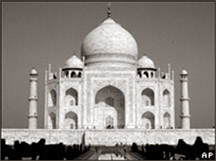Face mask to beautify Taj Mahal
|

The Taj Mahal's famous gleam has gone a bit yellow
|
Indian officials say a deep-cleansing mud pack may be the only way to
return a yellowing Taj Mahal to the cultural landmark's former white
marble glory.
Pollution particles have collected on the 17th Century marble
mausoleum, built by Mughal emperor Shahjahan for his wife.
A report put before India's parliament recommends caking the building
in clay to draw out surface impurities. The process is not cheap -
restoration will cost $230,000 (œ116,000).
"To restore the pristine glory of the Taj Mahal, as a conservation
measure, the clay pack treatment, which is non-corrosive and
non-abrasive, should be carried out for the removal of the accretionary
deposits," the report said.
The report recommends that the application of a mud pack should be a
regular event to keep the marble's surface clean.
The yellow tinge to the building's marble is blamed on high levels of
tiny dirt particles in the air which gather on the surface of the
marble. Ten years ago, the country's Supreme Court ordered thousands of
smoke-generating iron foundries and kilns near the building to be closed
or moved.
Vehicles cannot drive within 1.5 miles (2km) of the site and many of
its three million annual visitors make their way to the Taj Mahal on
horse-drawn carriages or battery-operated buses.
After the clay mixture has fully dried in the sun, it is washed off,
taking the layer of dirt with it and, it is hoped, exposing pristine
white marble beneath. The process takes about two months.
BBC NEWS
|
